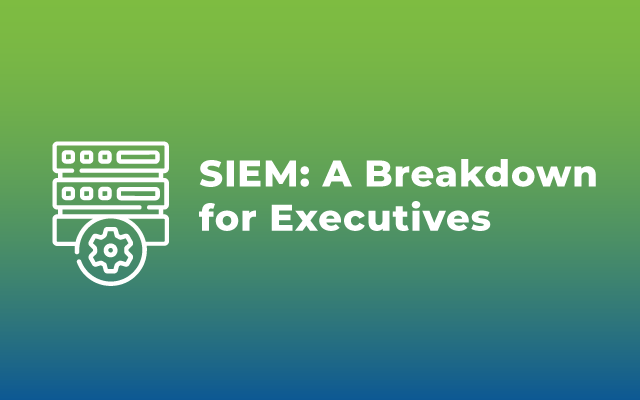Articles /
SIEM: Security Information And Event Management

Security Information and Event Management (SIEM) is a compilation of tools, software products, and services. The SIEM umbrella offers security data insights, event logging, and threat analysis to develop a deeper picture of an organization’s information security posture.
What is SIEM (Security Information & Event Management)?
Early SIEM technology relied on signatures to detect undesirable or suspect behavior. Modern SIEMs surface various abnormal behavior and events through sophisticated models and correlation rules. At its core, SIEM is a monitoring and logging system. Event and log generation systems are becoming more essential as complex cyberattacks impact compliance and regulatory mandates on security controls.
American Technology Services offers SIEM as a managed IT service. It is essential to differentiate between SIEM tools (SaaS) and professional managed security services that utilize SIEM tools as a resource for providing SIEM services. Ideally, all organizations should employ a Security Operation Center (SOC) team of experts to oversee the SIEM tools. This turns a tool into a logging and analysis source while keeping reporting accurate and actionable.
The National Institute of Standards and Technology (NIST) defines SIEM as an “application that provides the ability to gather security data from information system components and present that data as actionable information via a single interface.”
Interestingly, SIEM combines two cybersecurity technologies. The first is security information management (SIM), which aggregates data for analysis and reports on security events. The second is security event management (SEM), which provides thorough analysis and reporting through real-time system monitoring and network admin notification systems.
Log Management as a Component of SIEM
Event logs, also known as audit records, are detailed and text-based records about all the activity, past and present, in an operating system. Logs provide crucial intel regarding network, application, and server performance. This establishes a historical baseline for user activity and allows for the filtration of suspicious behaviors gathered from data sources.
All MSPs (Managed Service Providers) or MSSPs should have a SIEM system in place to establish baselines and sift through all the noise. Important logs that should be collected include validation features, access control failures, authentication attempts, changes in user access, and all log-in processes.
SIEM Highlights & Use Cases
- Real-time visibility across information security systems
- Detection of covert, malicious, or encrypted communications and channels
- Security dashboard with automatic security event notifications
- Event log management that aggregates data from many sources
- Correlation of events gathered from disparate logs or security services
- SIEM visibility and anomaly detection for zero-day or polymorphic code
- Security event and log failure pattern detection via SIEM visualization
- HIPAA, GDPR, and PCI compliance
SIEM Capabilities
- Data & Log Aggregation: A SIEM system will integrate with disparate sources such as device endpoints and security solutions. The SIEM must be configured to ensure it processes, and archives log data in near-real-time. This data and log information is normalized for analysis.
- Event Correlation: An essential component of all SIEM solutions is the analysis of aggregated log data derived from systems, endpoints, applications, and networks monitored by your organization.
- Alerts: A SIEM alert system is often used by SOC experts to act on any suspicious or irregular behavior found and reported by the SIEM solution. The SIEM identifies potential security issues using a set of predefined rules, automating manual processes, and enabling prompt response by the cyber security team.
- Dashboards: Dashboards are an integral part of any effective SIEM solution. After data and log aggregation, event correlation, and alerts are sent, analysis outcomes and insights are presented through dashboards. An ideal SIEM dashboard can come preconfigured or custom designed by your MSSP (Managed Security Service Provider) or SOC team.
- Compliance: Organizations and businesses concerned about compliance should invest in a SIEM solution to collect data, automate regulatory reporting, and safeguard data storage. This approach ensures compliance with company, industry, and government standards.
- Retention: SIEM solutions offer log and record storage with differing types and times for retention. Hot, searchable storage is usually kept for a short duration on hand. After a threshold time passes, logs are transferred to warm, searchable storage. When a longer, predetermined set of time passes, these logs are then moved to cold storage, where this is practically unlimited retention based on request and regulatory requirements.
ATS is an NYC and DC Metro-based Managed Security Service Provider. We offer SIEM and other cybersecurity services for associations, professional firms, government contractors, financial institutions, and non-profits.